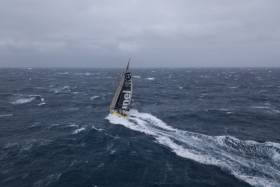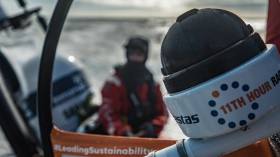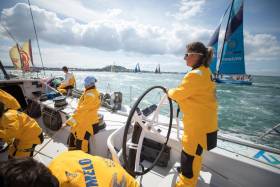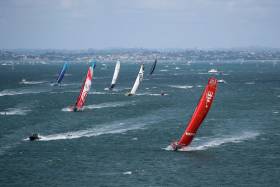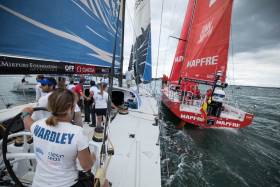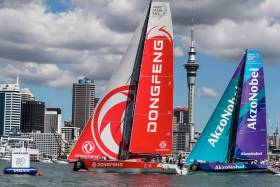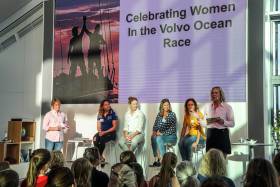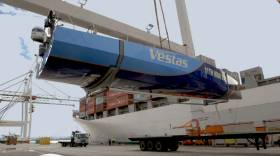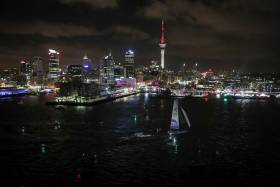Displaying items by tag: VOR
Southern Ocean Conditions Take Toll On Volvo Ocean Race Fleet
#VOR - The Southern Ocean is beginning to exact a toll on the Volvo Ocean Race fleet as conditions intensified today, Saturday 24 March.
The wind is consistently above 30 knots now, with gusts approaching 40 knots and the sea state is rising above five metres.
MAPFRE had been leading at 7am Irish time/UTC this morning, but subsequently reported damage to its mast, which has slowed the team somewhat, though they are still holding firm in second place.
“We have some small damage to the mast track,” wrote skipper Xabi Fernández in an email to race control this morning. “We have made a temporary fix and will continue racing.”
Navigator Juan Vila added: “The focus on board is to ensure we protect our boat and equipment. We had a small break in the mast track and now we have to balance pushing hard but knowing when to take our foot off the accelerator.”
Sun Hung Kai/Scallywag, already trailing the fleet by 100 miles this morning, also reported damage to a runner block, one of the pulleys guiding the rigging that supports the mast. It was quickly repaired and while the team lost some miles, no lasting damage was done.
“We were gybing along the Ice Exclusion Zone and the runner block (pulley) twisted upside down, so when we brought the new runner on it broke the block and stripped the runner tail,” explained skipper David Witt.
“We were lucky; we could have snapped the runner and lost the mast. So we had to jury rig a fix, put it back together and now we’re off and going again. We’re 110 miles behind, but that’s what happens.”
The teams are making fast progress towards Cape Horn, pushed onwards by the gale-force westerly winds behind them. But gybing along the southern boundary of the race course of the Ice Exclusion Zone is making for exhausting work.
“There’s 35 to 40 knots of breeze and big waves,” said Brunel skipper Bouwe Bekking, the eight-time race veteran. “On the one hand the sailing is really fun but on the other hand it’s pretty hairy because you know if you do something wrong it can go terribly wrong. So it’s always to find the balance.”
One team blazing along this weekend is Turn the Tide on Plastic. With Southern Ocean veterans like skipper Dee Caffari and navigator Brian Thompson leading the way, the team has worked its way to the head of the leaderboard at 1pm Irish time UTC, racing along at nearly 22 knots – the fastest in the fleet.
“Sending it under water most of the time! Gybe ho! Again and again. A busy day in lots of wind down here,” tweeted Caffari earlier.
The work is only just beginning.
Leg 7 Position Report, Saturday 24 March (Day 7) at 1pm Irish time/UTC:
- Turn the Tide on Plastic - DTF 4,154.5 nautical miles
- MAPFRE +6.3 nautical miles
- Team Brunel +11.8
- Team AkzoNobel +28.0
- Dongfeng Race Team +38.0
- Vestas 11th Hour Racing +39.7
- Sun Hung Kai/Scallywag +144.5
Volvo Ocean Race Fleet Turns East Bound For Cape Horn
#VOR - Vestas 11th Hour Racing posted the first 500-mile run of Leg 7 on Wednesday (21 March) as the Volvo Ocean Race fleet charges towards the ice exclusion zone.
Four days into the 7,600-mile leg from Auckland to Itajaí, there has been little let-up for the seven teams as they continue to push ever deeper into the Southern Ocean.
A north-easterly wind of 20 and 30 knots has guaranteed rapid sailing conditions and similar boat speeds from the Volvo 65s.
Vestas 11th Hour Racing clocked off 500.2 nautical miles in the 24 hours leading up to the 7am Irish time/UTC position report, with their six rivals all within 15 miles of the target.
Until now, the race has been to get due south as fast as possible to skirt round the bottom of a big anticyclone. But today the teams, split on the water by 25 miles, started to swing round to the east as the ice exclusion zone quickly approaches.
The shortest, and therefore technically the quickest, route will see the fleet bounce along the exclusion zone put in place by race management to keep the teams away from Antarctica’s icebergs.
At 1pm Irish time/UTC, Vestas 11th Hour Racing had slipped to second place, having surrender the top spot to team AkzoNobel as the fleet blasts east.
“It’s still pretty tight – we’ve got Dongfeng and MAPFRE coming at us pretty quickly at the moment, and we can see Brunel’s light up to windward,” Akzonobel’s navigator Jules Salter explained.
“Everyone’s doing 22, 23 knots so we’re really only 10 or 15 minutes apart from each other. The sea state and the wind is changing all the time, and we’re just trying to find the right combination for the sails. The guys on deck have a lot of work on.”
The next challenge facing the teams comes in the shape of a monster depression brewing to the south containing winds in excess of 40 knots.
“There’s definitely some more wind coming, that’s for sure,” Salter added. “We’ll also have to start doing a few gybes and that’s going to be pretty tricky in those big winds and waves. The hardest bit is yet to come.”
The impending storm is also at the forefront of Dongfeng Race Team skipper Charles Caudrelier’s mind as he spurs on his fifth-placed team.
“There will be five tough days to go until we reach Cape Horn,” Caudrelier said. “Five days is long in these conditions when you are close to the ice limit, in the coldest area, with many manoeuvres – it really is going to be very hard.
“We will really have to look after the boat and the sailors because there will be a lot of rough sea, a lot of wind and a lot of rotations. This is the worst because manoeuvres in these conditions and in the big seas are difficult, but we have no choice. This is it – the Great South.”
As well as living with the constant damp and plummeting sea and air temperature, Bouwe Bekking’s fourth-placed Team Brunel has had other issues to contend with.
“It just feels like there’s always something to do,” Abby Ehler explained. “We had a couple of breakages on the first day, we’ve got a little tear in the J2 and our AIS isn’t working, which is a real hindrance not being able to see the rest of the fleet. We’re working our way through all these mishaps.”
Each team will be working to get their equipment in the best shape possible before the big breeze forecast for the coming days.
Leg 7 Position Report, Wednesday 21 March (Day 4) at 1pm Irish time/UTC:
- Team AkzoNobel - DTF 5,517 nautical miles
- Vestas 11th Hour Racing +3.36 nautical miles
- MAPFRE +6.26
- Team Brunel +6.72
- Dongfeng Race Team +7.28
- Turn the Tide on Plastic +17.03
- Sun Hung Kai/Scallywag +20.69
#VOR - An intense start saw the seven-boat Volvo Ocean Race fleet – back up to full complement with the return of Vestas 11th Hour Racing – sail straight into a 30-knot easterly just hours after the leg start on Sunday.
Monday has brought little let-up with winds hovering around 25 knots producing similar boat speeds as the teams charge deeper into the Southern Ocean on the 7,600-mile leg.
An opening day lead for Dongfeng Race Team and MAPFRE was cut short when Turn the Tide on Plastic and Team AkzoNobel skirted round the outside of the fleet as it piled into an unpredicted wind hole.
The manoeuvre gave Caffari’s crew a slim lead of around two miles on Vestas, with the chasing pack a further five miles adrift.
“Ourselves and Turn the Tide on Plastic just pulled off a nice ‘Buffalo Gals’ move as the rest of the fleet parked in a cloud,” Vestas navigator Simon Fisher explained, referencing Malcolm McLaren’s 1982 hip hop hit that includes the lyrics ‘Buffalo gals go round the outside’.
Caffari has set sail with a number of familiar faces from Leg 3 late last year, from Cape Town to Melbourne, so they come with previous experience of the Southern Ocean.
“The only real change is that Martin Strömberg due to injury isn’t with us so this is Henry Bomby’s opportunity to experience the Southern Ocean and that's the only real change we’ve made outside of the planned changes. It’s the team I'm comfortable with, confident with and we're going to do the best we can,” said the TTOP skipper.
Ireland’s own Annalise Murphy is sitting out this leg but remains on standby.
Meanwhile, Bouwe Bekking’s Team Brunel were left scratching their heads as the two teams passed them.
“Wow, what is happening here?!” a tweet from Brunel account asked. “Turn the Tide on Plastic and Vestas 11th Hour Racing are on the highway as we park up. There’s supposed to be a 15-knot easterly breeze?”
With the easterly breeze forecast brought on by an anticyclone due to remain in place for several days before backing, the tactics early on is relatively straight forward – dive south as fast as possible.
Only when the wind turns more to the north will the fleet be able to start the curve towards Cape Horn and the heavy weather that lies in wait further down the line.
“For the next three days it should be quite simple,” Dongfeng’s Kevin Escoffier said. “We’re going straight south towards the ice limit, then turning round the bottom of the high pressure.
“Then we’ve got a front to pass, and it will be a completely different story after that. The forecast is for windy weather, so now we have to sleep, get some rest, and be ready for this part of the race.”
For Vestas skipper Charlie Enright, the start of the leg means the resumption of his team’s quest for Volvo Ocean Race glory having had to sit out Leg 6 with damage to their boat.
“It feels good to be back on the water,” he said. “We’re a little on the back foot but I guess that’s to be expected. We feel good that we’ve got another 7,000 miles ahead of us. It’s all or nothing – we treat every leg the same. We certainly couldn’t try any harder.”
Mark Towill, Vestas co-skipper, added: “We’ve just go to out-work all these other guys. It’s just going to come down to hard work and determination. We’ve got plenty of that.”
At 1pm Irish time/UTC there was a split of just 17 miles from Turn the Tide on Plastic to seventh-placed Team Sun Hung Kai/Scallywag – and with Leg 7 counting for double points, the action is guaranteed to be closer than ever.
Leg 7 Position Report, Monday 19 March (Day 2) at 1pm Irish time/UTC:
- Vestas 11th Hour Racing - DTF 6,287.13 nautical miles
- Turn the Tide on Plastic +1.5 nautical miles
- MAPFRE +4.1
- Team Brunel +4.66
- Dongfeng Race Team +8.34
- Team AkzoNobel +9.16
- Sun Hung Kai/Scallywag +18.81
#VOR - It was a spectacular start to Leg 7 of the Volvo Ocean Race as the fleet left Auckland in perfect conditions on Sunday afternoon, 18 March.
The sun was out, the wind was near 20 knots, and as they have for 10 stopovers, the Auckland fans took to the water by the thousands to farewell the fleet. It wasn’t a surprise – over the course of the Auckland stopover, over 500,000 fans came through the Race Village at the Viaduct Basin.
On Sunday afternoon the Kiwi spectator armada consisted of foiling kite-boards, windsurfers, stand-up paddle boards, kayaks, sailing dinghies, as well as hundreds of power and sail boats, along with the former Whitbread Round the World Race winner Steinlager 2.
It was MAPFRE, the overall race leader, who made the best start to lead the fleet around a loop of the Waitematā Harbour and out into the Hauraki Gulf, with Dongfeng Race Team, Team Brunel and Turn the Tide on Plastic in close and giving chase.
Within a few hours, it was MAPFRE doing the chasing – some six nautical miles behind, and scrapping with Sun Hung Kai/Scallywag, as Team Brunel took pole, with Dongfeng just a fraction of a mile behind, Team Akzonobel in third, Vestas 11th Hour Racing fourth and Turn the Tide on Plastic in fifth. All told, the first five teams were within one-and-a-half miles as of 10am Irish time/UTC.
“It’s going to be upwind and bumpy until East Cape,” said Vestas 11th Hour Racing navigator Simon Fisher ahead of the leg start. His team is returning to the race after retiring from Leg 4 and missing the leg into Auckland while repairing damage to their hull.
“Going around Cape Horn represents a real milestone in the race. It’s a big thing to get around the Horn and it’s a moment of celebration for everyone on board as it means the end of the Southern Ocean and back to the relative safety of the South Atlantic.
“But by no means is it a moment to relax as some of the biggest challenges of this leg can be found between Cape Horn and the finish in Itajaí.”
In a return to the heritage of the event, Leg 7 of the Volvo Ocean Race will take the teams on a 7,600 nautical mile journey into the Southern Ocean, and around the iconic Cape Horn, before returning to the Atlantic Ocean towards the finish in Itajaí, Brazil.
“100% of the sailors that have done this leg have at one moment said it is too hard or too tough,” said Charles Caudrelier, the skipper of Dongfeng Race Team. “But when you pass Cape Horn you have a huge feeling of pride that you have faced your fears.”
“We’re going into one of the more gruelling legs of the race,” added Brunel’s Peter Burling, a hero in New Zealand for bringing the America’s Cup home last summer.
“The biggest challenge is the endurance aspect, having to keep the intensity high through some very difficult conditions… It’s going to be pretty tough for any of us Kiwis to leave here, but we’re all pretty excited to get into it.”
The initial Ice Exclusion Zone will allow the teams to sail as far south as 59-degrees south latitude, well into the ‘Furious Fifties’, where wind and waves circle the planet unimpeded by land, allowing them to build to fearsome levels. It will be very cold that far south, and the routing will take the fleet to the most remote part of the world, Point Nemo, where the international space station is closer than any point of land.
There is a balance to be struck on this leg, between pushing the crew and equipment hard in the quest for victory, and ensuring the team is able to finish the leg at all.
“This is a part of the world where sometimes you have to forget about the race and just take care of the people and the boat,” noted Caudrelier. “It's a special place, sailing in the South - the sea is bigger, the wind is stronger, so you need to be mindful.”
The teams got straight into it – after leaving the final turning mark, the forecast was for an upwind slog into a 30-knot easterly as they aimed to clear the Coromandel Peninsula and then the East Cape of New Zealand, before turning south in search of the low pressure systems that will power them towards Cape Horn, some 11 days away.
The initial ETA for the finish in Itajaí, Brazil is between Wednesday 4 and Friday 6 April.
Leg 7 Position Report, Sunday 18 March (Day 1) at 10.15am Irish time/UTC:
- Team Brunel - DTF 6,545.6 nautical miles
- Dongfeng Race Team +0.2 nautical miles
- Team AkzoNobel +0.8
- Vestas 11th Hour Racing +1.0
- Turn the Tide on Plastic +1.4
- Sun Hung Kai/Scallywag +6.0
- MAPFRE +6.6
Volvo Ocean Race Sailors Ready To Tackle Southern Ocean
#VOR - Seven Volvo Ocean Race teams will embark on one of the most classic legs in offshore racing on Sunday afternoon (18 March) from Auckland, New Zealand.
Leg 7 of the Volvo Ocean Race is an iconic Southern Ocean challenge: a 7,600 nautical mile race through the ‘Furious Fifties’ — the inhospitable, remote waters south of 50-degrees latitude that circle Antarctica — around Cape Horn and up to Itajaí, Brazil.
“It’s going to be bloody cold,” said Bouwe Bekking, skipper of Team Brunel, who is on his eighth lap of the planet. “It’s probably the best sailing you can get. We know the boats so well at this point in the race, we will be pushing 100 per cent.
“And going around Cape Horn is a big psychological boost as you know the Southern Ocean is behind you, every mile you go north it gets warmer. So it’s a funny thing, there will be moments when you hate it, but you know better times are ahead and when you arrive in Brazil, you forget the bad parts and the good parts stay with you.”
Leg 7 is a double-point scoring leg, with an additional bonus point awarded to the first boat to pass Cape Horn. With so many points on offer, this classic Southern Ocean leg, a return to the roots of the race, has the potential to be decisive on the leaderboard.
MAPFRE is the overall leader following six legs, but after a fourth-place finish and late charge to get on the podium on the leg into Auckland, the team’s position at the top doesn’t appear as secure as it was early on.
“Of course I feel like they are coming closer and faster, but we can only do one thing – push the boat, sail well and try to win this leg,” said MAPFRE skipper Xabi Fernández, who has six previous roundings of Cape Horn to his credit.
“If we can win this leg, it’s a big step forward. There is nothing to change, we just need to sail a little bit better than the others and push a little bit harder.”
Sun Hung Kai/Scallywag is one of the teams putting pressure on the leaders. The team is coming off one-two finishes on the last two legs, vaulting up the leaderboard to third place. Skipper David Witt was succinct when asked about his approach to this Southern Ocean leg.
“We’re going to win the leg or drop the rig. That’s the mentality,” Witt said. “This is a big chance for Scallywag to stay up there and do something or drop back towards the back of the pack… We don’t care what goes wrong or what breaks… We’re just going to send it.”
Another team making a push up the leaderboard is Team AkzoNobel. Skipper Simeon Tienpont led his team to victory on the race into Auckland, and now he’s determined to continue the charge.
“You always have to look at the race as a whole and there’s more than 50 per cent to go in terms of points. It’s been a big improvement and a big learning curve. We’re working unbelievably hard and we want to keep the momentum going. The leg win into Auckland proved we’re on the right track and gives some confidence.”
The Ice Exclusion Zone for Leg 7 is set very far south, at points diving as deep as the 59-degree south latitude line. In theory, this will shorten the distance the boats need to sail, and speed up the leg. But it comes at a cost: more bitter cold and towering seas, in wind and waves that circle the planet unimpeded. The challenge isn’t lost on the sailors.
“You can’t ignore where you’re going and the responsibility that lies with the skipper,” said Dee Caffari, skipper of Turn the Tide on Plastic. “But we have already had Leg 3, from Cape Town to Melbourne. Everybody has had a taste of how wet, cold and windy it can be. We’re not going down into the unknown, which gives you a lot more confidence.”
Dongfeng Race Team skipper Charles Caudrelier can speak first-hand about how challenging this part of the world can be.
“It’s a difficult leg for sure. Sometimes you have to forget the race and take care of the boat and the crew,” he said. “I know this very well. I’ve done this leg twice and never finished with the mast up! And Pascal [Bidégorry] did this leg twice and he’s never made it past Cape Horn!! So that is one of our goals, make it past Cape Horn and finish with the mast up!”
Rejoining the fleet is Vestas 11th Hour Racing after missing the last two legs with damage sustained in a collision near the end of Leg 4. Skipper Charlie Enright says his team is eager to get racing again and resume challenging the leaders.
“The team has come together great, the repair has come together great,” he said. “There are 16 points available to the winner and to put that into context, we have 23 points now, so it’s going to be a big move and shake. We had a successful Southern Ocean leg last time and we’re looking to repeat that performance.”
Leg 7 will start at 2pm local time in Auckland (1am Irish time/UTC) this Sunday 18 March. Catch a live stream of the action from 12.45am UTC on the VOR website or Facebook Live, or join the live conversation on Twitter.
#VOR - Dongfeng Race Team showed great concentration and resilience in winning the New Zealand Herald In-Port Race in Auckland, New Zealand earlier today (Saturday 10 March).
Conditions were extremely light, shifty and patchy on the Waitematā Harbour for the Volvo Ocean Race fleet, making for plenty of lead changes over the course of the one-hour race.
Team AkzoNobel finished in second place, while early leaders MAPFRE completed the podium to retain the overall lead in the In-Port Race Series.
“It was very tricky, very difficult,” said Dongfeng skipper Charles Caudrelier following the race. “We had a terrible start but there was so much happening during the first leg that it wasn’t always good to be in the lead as you just showed the others where the light spots were. We were able to pick up on that and sail around the leaders.
“We worked hard on our speed, and managed to come back slowly.”
The race started in spectacular fashion, considering how light the wind was. MAPFRE positioned well to leeward of the fleet, was first across the line, with David Witt’s Scallywag barging through with speed ahead of a big group clustered near the pin end.
But in fact, it was Team Brunel who were causing the pile-up at the pin, forcing three boats outside of the start line, with Dongfeng, Turn the Tide on Plastic and Team AkzoNobel all required to re-start well behind the leaders.
That left MAPFRE and Scallywag as the early leaders, charging up what appeared to be a one-tack leg.
But as they approached the top third of the leg, the wind died, and the trailing boats were able to sail around the leading pair on both sides, with AkzoNobel and Vestas 11th Hour Racing squeezing through just ahead of Dongfeng Race Team and Brunel Sailing.
On the nominally downwind second leg, AkzoNobel and Dongfeng found a vein of pressure to grab the lead, and on a shortened two-lap course, it was Dongfeng who were able to ease ahead and hold on for the win.
“It was a good team win,” said Caudrelier. “Very good for the mood of the team.”
The results mean MAPFRE retains the overall lead in the series, with Dongfeng reducing the gap to second place and Team AkzoNobel leapfrogging Brunel to take third.
Watch the full In-Port Race below:
Leg 7 of the Volvo Ocean Race from Auckland to Itajaí starts next Sunday 18 March.
Current Volvo Ocean Race In-Port Race Series Leaderboard:
- MAPFRE – 37 points
- Dongfeng Race Team – 34 points
- Team AkzoNobel – 27 points
- Team Brunel – 26 points
- Vestas 11th Hour Racing – 18 points
- Sun Hung Kai / Scallywag – 15 points
- Turn the Tide on Plastic – 11 points
Celebrating Inspirational Female Volvo Ocean Race Sailors On International Women's Day
#VOR - The Volvo Ocean Race celebrated 45 years of women in the race with a landmark event in Auckland on International Women’s Day, Thursday 8 March.
The event, organised by the Magenta Project, and supported by Volvo Ocean Race supplier GAC Pindar, saw iconic women from across the decades take to the stage to reflect on their experiences in Volvo Ocean Races of the past – and join the conversation on the future, in front of a packed crowd of over 200 attendees.
Three-time Volvo Ocean Race veteran Abby Ehler co-hosted the event, and was joined on stage by a panel consisting of Australian Leah Fanstone (US Challenge/Heineken 1993-94; EF Education 1997-98), Lisa McDonald (EF Education 1997-98; Skipper of Amer Sports Too, 2001-02), Dongfeng’s Carolijn Brouwer and Vestas 11th Hour Racing’s Hannah Diamond.
Over 20 female sailors — including Ireland’s own Annalise Murphy — have already competed in the race this edition, compared to just 200 in the four decades previously.
“It’s incredible to see the support for female participation in the event, from all corners of the sport,” said Ehler, who also competed on Amer Sports Too in 2001-02, and the all-female Team SCA in 2014-15.
“The Volvo Ocean Race has made great strides by introducing the mixed crew initiative prior to this edition, but it’s really key to keep the ball rolling in order to avoid a frustrating 12-year gap like myself and many others experienced after the 2001-02 edition.”
Ehler added: “How long will it take until there are as many women as men, with the right amount of experience and skills, competing at the top level of offshore sailing? We think the answer lies in this room, and those within the sailing industry.”
#VOR - Organisers of the Volvo Ocean Race have commissioned an independent report into ocean racing at night in areas of high vessel traffic density, to establish what steps race organisers may take to mitigate risk going forward.
The move follows the collision between Vestas 11th Hour Racing and a non-racing vessel in the final stages of the Leg 4 into Hong Kong, which resulted in the death of a fisherman.
The report will be conducted by an Independent Report Team (IRT), chaired by Rear Admiral Chris Oxenbould AO RAN (Rtd) and assisted by Stan Honey and Chuck Hawley.
Rear Admiral Oxenbould is a former deputy chief of the Australian Navy and an experienced ocean racing yachtsman with a particular expertise in navigation. He is also the former chairman of Australia Sailing’s National Safety Committee.
Renowned current sailor and ocean navigational expert Stan Honey, who won the Volvo Ocean Race 2005-06 as navigator onboard ABN AMRO ONE, and Chuck Hawley, former chairman of the US Sailing Safety at Sea Committee, will assist Rear Admiral Oxenbould on the report.
The IRT will examine all the issues associated with racing a Volvo Ocean 65, or similar racing boat, at night in areas of high vessel traffic density, drawing on the experiences in recent editions of the Volvo Ocean Race.
Any findings from the report that could benefit the wider sailing community will be released. It is intended that the IRT will make its report available to Volvo Ocean Race by June 2018.
Race director Phil Lawrence said: “Understandably, there has been a lot of reaction to this incident in the sailing community, but the fact is, it takes time to make a responsible assessment of what could be done differently to minimise risk and increase safety.
“Our sailors, as qualified professionals, understand their responsibilities under the International Regulations for Preventing Collisions at Sea, Racing Rules of Sailing and the Rules of the Volvo Ocean Race.
“As race organisers, we will continue to evaluate safety as we race over the coming months and take the appropriate steps to minimise risk,” Lawrence added.
Meanwhile, Vestas 11th Hour Racing is preparing to rejoin the Volvo Ocean Race fleet for Leg 7 from Auckland to Itajaí in Brazil, which sets sail later this month.
Vestas withdrew from Legs 5 and 6 for shipping their boat directly to New Zealand for repairs — and in a statement, the team says its crew return to the race “with a mixture of heavy hearts and anxiousness”.
Team AkzoNobel Holds Off Late Charge To Win Epic Volvo Ocean Race Leg 6 Into Auckland
#VOR - Team AkzoNobel has won Leg 6 of the Volvo Ocean Race, racing 6,344 miles from Hong Kong to Auckland in 20 days, 9 hours and 17 minutes and 26 seconds.
The result came after an epic final 24 hours, when a ridge of high pressure off the north east coast of New Zealand stalled the progress of the leading boats, allowing those behind to close what had appeared to be an insurmountable gap.
For Team AkzoNobel and Sun Hung Kai/Scallywag, the buffer they’d built up over the past week was only just sufficient, and they were able to match race down the coast all the way to the finish line in the Waitematā Harbour, usually sailing within hailing distance of each other.
In the end, the margin at the finish was just two minutes between first and second place.
“It’s been a 6,500 mile match race, it’s unreal,” said AkzoNobel skipper Simeon Tienpont. “I’ve never sailed a race like this in my life. We’ve always been in each other’s sights. They were always there. It’s been neck and neck.
“Huge respect to Scallywag, they never stopped fighting and we never stopped defending. I’m so proud of our crew. They never flinched.”
It’s the first leg win for team AkzoNobel and earns the team an important 8 points on the leaderboard, after fighting all the way to the finish with Scallywag.
“Our team never gives up,” said Scallywag skipper David Witt. “We just didn’t pull it off this time. We had our chances, but AkzoNobel were just a little bit too good this time. But we’ve come a long way since leg one.”
The second place finish in Leg 6, combined with a leg win into their home port of Hong Kong, has elevated Scallywag up to third place on the overall leaderboard.
While the weather pattern of the last 24 hours has made for a heart-stopping finish for race fans, it also led to a heart-breaking result for Dee Caffari’s Turn the Tide on Plastic.
Just 24 hours ago, Caffari and her team appeared poised to claim their first podium of the race, even while challenging for the leg win. MAPFRE and Dongfeng Race Team, first and second on the overall leaderboard, were over 60 miles behind Caffari. It would have made for a well-earned and popular result for an underdog team.
But as the leading trio bumped up against an unavoidable patch of calm winds, MAPFRE and Dongfeng roared in, closing the gap down minute by minute.
As darkness fell on Tuesday night and the wind picked up for the final 60-mile sprint to the finish, the two powerhouse red boats were within striking distance of Caffari and her team, just two miles back.
And over the next 90 minutes, they were able to grind their way past, pushing Turn the Tide on Plastic back into fifth place with 20 miles to run.
While Caffari and her crew — among them Ireland’s Olympic hero Annalise Murphy — showed incredible fighting spirit, clawing ahead of Dongfeng Race Team once again as the boats raced through the Hauraki Gulf on the final approach, they couldn’t hold on, and would need to settle for fifth place, behind both MAPFRE in third and Dongfeng in fourth.
“It’s been a crazy 20 or 21 days, match racing all the way here,” said MAPFRE skipper Xabi Fernández. “We’ve been fighting with Dongfeng like crazy. We never stopped, we fought so hard, and now we feel very happy of course. We were hoping for opportiunites in the doldrums and they never came, but finally they came today, and we did it.”
“We’re sorry for Turn the Tide on Plastic,” said Dongfeng skipper Charles Caudrelier. “They did a fantastic race and I think they deserved a third place finish, but that’s sailing, they’ve been unlucky today and we managed to come back… It was a good surprise.”
Overlooking the immediate disappointment of the day, this marks the best result of the race to date for Turn the Tide on Plastic and is a sign of progress for a young and improving team.
“We’re gutted, I don’t even know what to say,” said an obviously disappointed Caffari dockside. “We had a good race, and we thought we were going to have a better result. But those pesky red boats always seem to get it their way.”
Team Brunel remains on the race course, speeding towards the finish approximately 90 minutes behind their fellow competitors after falling victim to a bold tactical choice over the weekend that backfired and put them behind the rest of the fleet.
Vestas 11th Hour Race did not sail in Leg 6 after being shipped to Auckland for repairs. The team has lost ground on the leaderboard, with both Scallywag and AkzoNobel overhauling them to hold down third and fourth place, with Vestas 11th Hour Racing sliding to fifth. The team is expected to release an update over the coming days.
Current Volvo Ocean Race In-Port Race Series Leaderboard:
- MAPFRE – 39 points
- Dongfeng Race Team – 34 points
- Sun Hung Kai/Scallywag – 26 points
- Team AkzoNobel – 23 points
- Vestas 11th Hour Racing – 23 points
- Team Brunel – 18 points
- Turn the Tide on Plastic – 12 points
One Final Hurdle For Volvo Ocean Race Fleet On Approach To Auckland
#VOR - The finish of Leg 6 of the Volvo Ocean Race is shaping up to be a nail-biter after Team AkzoNobel emerged from Stealth Mode on the public tracker on Monday holding the narrowest of leads with just under 200 miles to go.
The Dutch team reappeared on the tracker shortly after 1pm Irish time/UTC, ending 24 hours of mystery surrounding their position – and revealing that less than 12 miles separated them from third-placed Turn the Tide on Plastic.
Interestingly, their position wasn’t included on the 1pm position report to the fleet, as they were just over 200 miles from the finish, so the other boats won’t get their confirmed position until the 7pm position sked.
(Under the rules of the event, once the lead boat closes to within 200 miles of the finish line, Stealth Mode ends for the entire fleet.)
Simeon Tienpont’s crew had opted to ‘go stealth’ – hiding their position from their rivals and race fans – on Sunday in a bid to consolidate their lead on chasers Team Sun Hung Kai/Scallywag and Turn the Tide on Plastic.
But rather than extend their advantage, Tienpont’s team saw it reduced as they became the first boat to hit a patch of light wind lying off the northern tip of New Zealand.
The leading trio all have to navigate through the light winds, but AkzoNobel reaching it first has allowed Scallywag and Turn the Tide to maintain speed for a few precious moments longer and close the gap.
The lighter breeze stretches around 70 miles from North Cape to Cape Brett at the entrance to the Bay of Islands before moderate north-easterlies will fill in providing fast reaching conditions into the finish line.
In essence, that gives Scallywag and Turn the Tide on Plastic just 70 miles to make any kind of passing move on Akzonobel.
With a tricky 24 hours left at sea, the Leg 6 podium is far from decided.
“We’ve got a little bit of a buffer but getting from North Cape to Cape Brett is looking light and shifty,” AkzoNobel’s Brad Farrand said. “The next 12 hours are going to be crucial.”
With the top three teams so close, Farrand said nothing was being taken for granted.
“Winning the leg isn’t something we’re talking about,” he said. “We’ll wait for it to happen, and then we can talk about it.”
On board second-placed Scallywag, skipper Dave Witt was taking delight in watching the deficit to AkzoNobel reduce with each position report.
“The breeze is going to disappear going round the top of New Zealand,” he said. “Akzo are going to get there first and they will be pushing the tide for a few hours. We won’t. There might be a little bit of a restart here.”
The dilemma facing the top three teams is whether to punch into adverse current closer to the coast on the shorter route to the finish line or head further offshore to pick up favourable current at the cost of more miles.
As Turn the Tide on Plastic chase their first podium finish, skipper Dee Caffari said she was prepared to push her crew – among them Annalise Murphy – to the limit.
“When we get to the light patch we will run a standby watch so we’ve got extra people to move things around and furl things so the drivers and trimmers stay focused,” Caffari said. “Then, when the wind fills in, we’ll have everyone up so we’re ready for anything. We’ll leave nothing left in the tank.”
Early leg leaders Team Brunel slipped to sixth after a gamble to find wind closer to the coast of New Caledonia failed, allowing Dongfeng Race Team and MAPFRE to slip past.
At 1pm UTC, Bouwe Bekking’s crew were trailing the two red boats by almost 100 miles, and the leaders by almost double that.
“We’re still fighting so we might still be able to catch up but it’s looking unlikely,” Brunel’s Kyle Langford said.
“We’ll do everything we can to catch those guys, but it’s disappointing that when we’ve been performing much better this leg to see it all slipping away.”
Meanwhile, MAPFRE and Dongfeng continue to engage in their own private match race. On the 1pm report, the two were within less than a mile of each other. This is a battle that appears destined to continue all the way into the Waitemata Harbour finish line.
The latest ETA for the leaders is early afternoon Irish time tomorrow, Tuesday 27 February.
Leg 6 Position Report, Monday 26 February (Day 20) at 4pm Irish time/UTC:
- Team AkzoNobel - DTF 189.1 nautical miles
- Sun Hung Kai/Scallywag +4.9 nautical miles
- Turn the Tide on Plastic +13.3
- Dongfeng Race Team +69.8
- MAPFRE +70.5
- Team Brunel +152.8





























